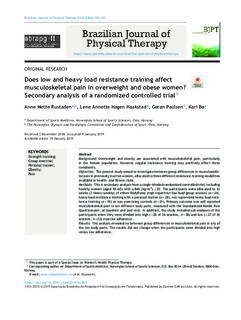| dc.contributor.author | Rustaden, Anne Mette | |
| dc.contributor.author | Haakstad, Lene Annette Hagen | |
| dc.contributor.author | Paulsen, Gøran | |
| dc.contributor.author | Bø, Kari | |
| dc.date.accessioned | 2019-05-15T14:37:06Z | |
| dc.date.available | 2019-05-15T14:37:06Z | |
| dc.date.created | 2019-01-31T13:08:36Z | |
| dc.date.issued | 2019 | |
| dc.identifier.citation | Brazilian Journal of Physical Therapy. 2019, 23, 156-163. | nb_NO |
| dc.identifier.issn | 1413-3555 | |
| dc.identifier.uri | http://hdl.handle.net/11250/2597734 | |
| dc.description.abstract | Background: Overweight and obesity are associated with musculoskeletal pain, particularly in the female population. However, regular resistance training may positively affect these complaints. Objective: The present study aimed to investigate between group differences in musculoskeletal pain in previously inactive women, allocated to three different resistance-training modalities available in health- and fitness clubs. Methods: This is secondary analysis from a single-blinded randomized controlled trial, including healthy women (aged 18–65) with a BMI (kg/m2) ≥25. The participants were allocated to 12 weeks (3 times/weekly) of either BodyPump (high-repetition low-load group session) (n = 24), heavy load resistance training with a personal trainer (n = 28), non-supervised heavy load resistance training (n = 19) or non-exercising controls (n = 21). Primary outcome was self-reported musculoskeletal pain in ten different body parts, measured with the Standardized Nordic Pain Questionnaire, at baseline and post-test. In addition, the study included sub-analyses of the participants when they were divided into high (≥28 of 36 sessions, n = 38) and low (≤27 of 36 sessions, n = 22) exercise adherence. Results: The analysis revealed no between group differences in musculoskeletal pain in any of the ten body parts. The results did not change when the participants were divided into high versus low adherence. Conclusions: Twelve weeks of BodyPump, heavy load resistance training with a personal trainer and non-supervised heavy load resistance training did not show any effect on self-reported musculoskeletal pain in overweight women. | nb_NO |
| dc.language.iso | eng | nb_NO |
| dc.subject | strength training | nb_NO |
| dc.subject | group exercise | nb_NO |
| dc.subject | personal trainer | nb_NO |
| dc.subject | obesity | nb_NO |
| dc.subject | pain | nb_NO |
| dc.title | Does low and heavy load resistance training affect musculoskeletal pain in overweight and obese women? Secondary analysis of a randomized controlled trial | nb_NO |
| dc.type | Journal article | nb_NO |
| dc.type | Peer reviewed | nb_NO |
| dc.description.version | publishedVersion | nb_NO |
| dc.rights.holder | © 2019 Associação Brasileira de Pesquisa e Pós-Graduação em Fisioterapia. Published by Elsevier Editora Ltda. All rights reserved. | nb_NO |
| dc.source.pagenumber | 8 | nb_NO |
| dc.source.journal | Brazilian Journal of Physical Therapy | nb_NO |
| dc.identifier.doi | 10.1016/j.bjpt.2019.01.005 | |
| dc.identifier.cristin | 1670341 | |
| dc.description.localcode | Seksjon for idrettsmedisinske fag / Department of Sports Medicine | nb_NO |
| cristin.unitcode | 150,34,0,0 | |
| cristin.unitname | Seksjon for idrettsmedisinske fag | |
| cristin.ispublished | true | |
| cristin.fulltext | original | |
| cristin.qualitycode | 1 | |
